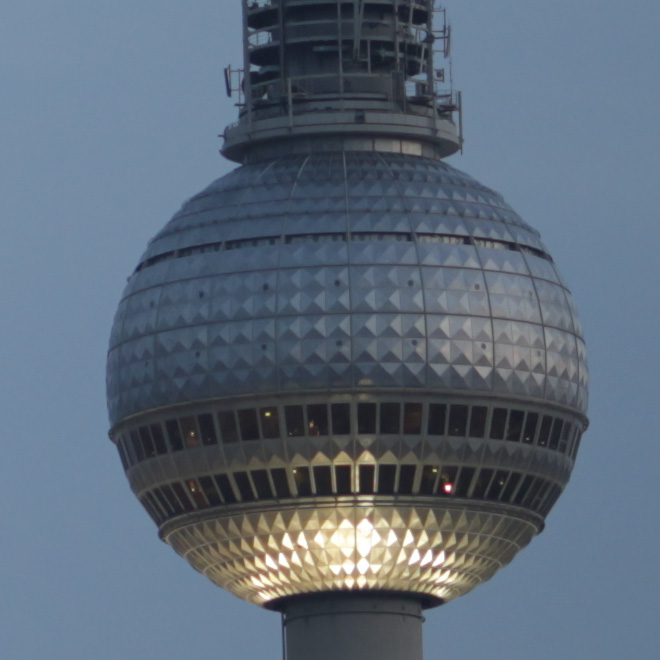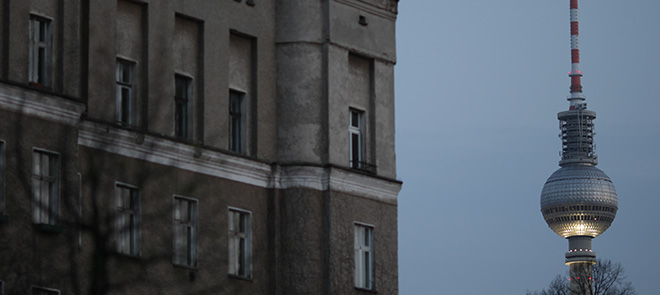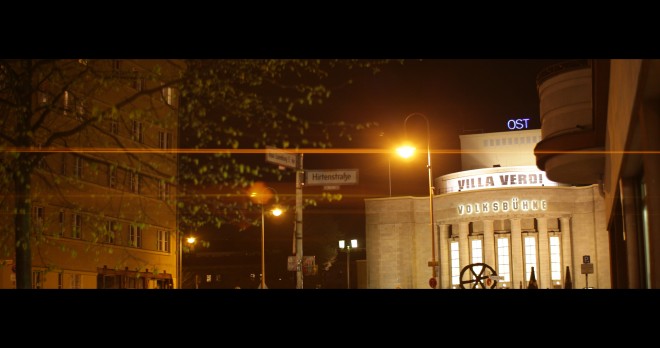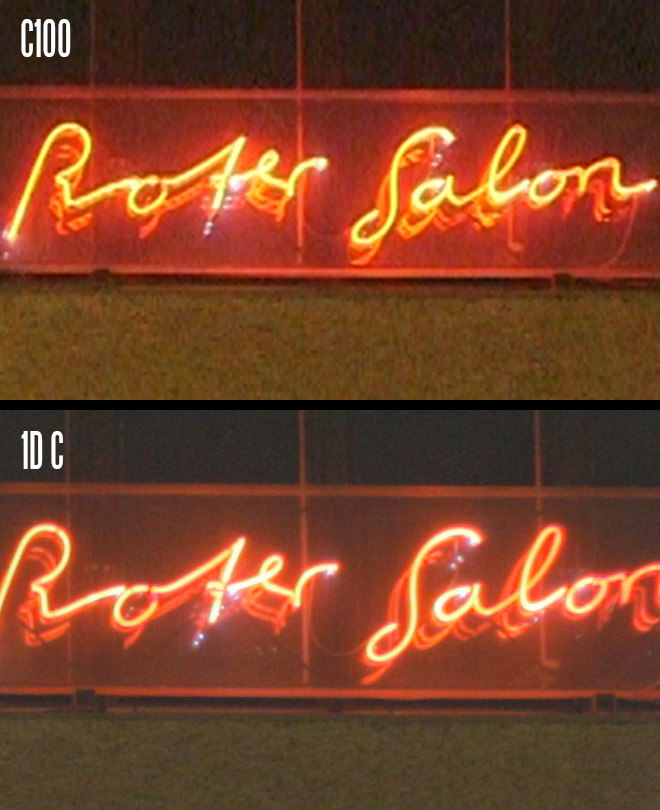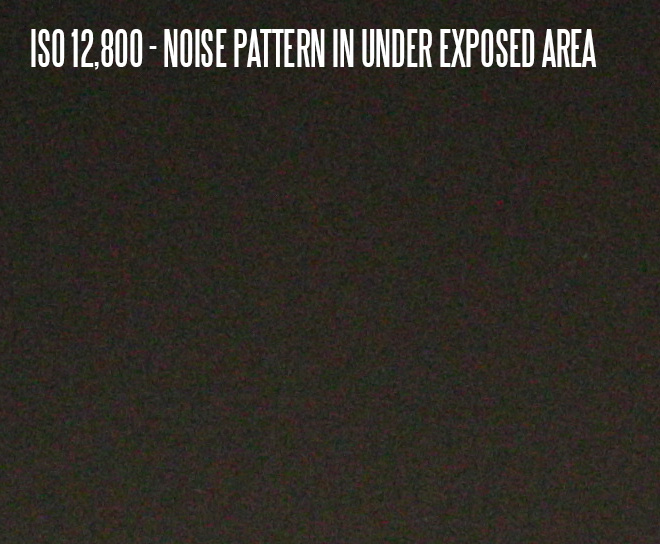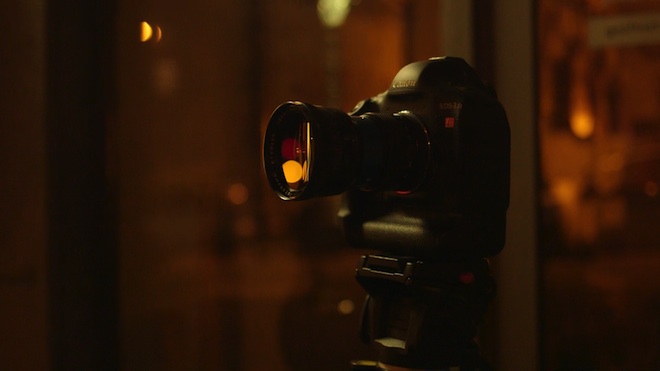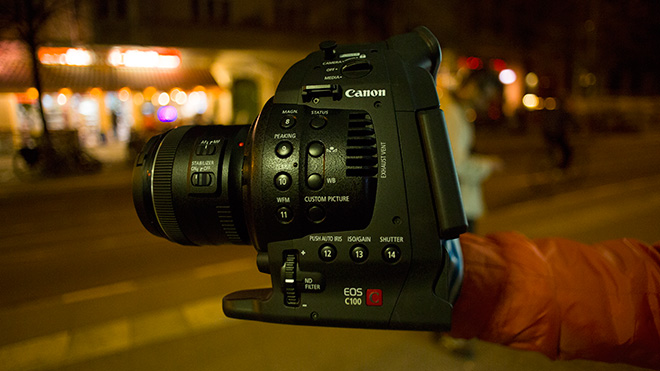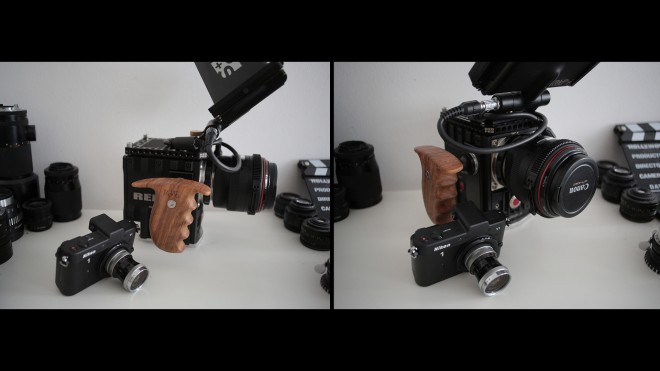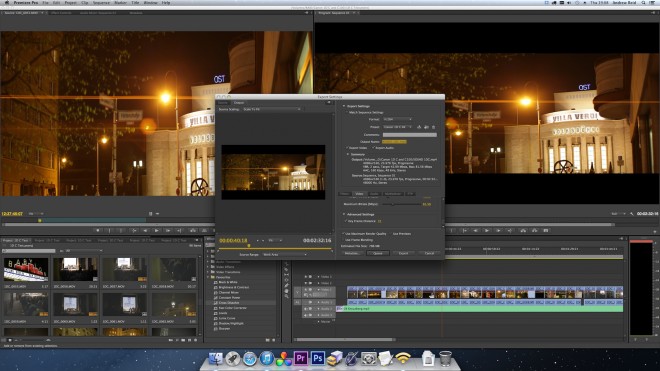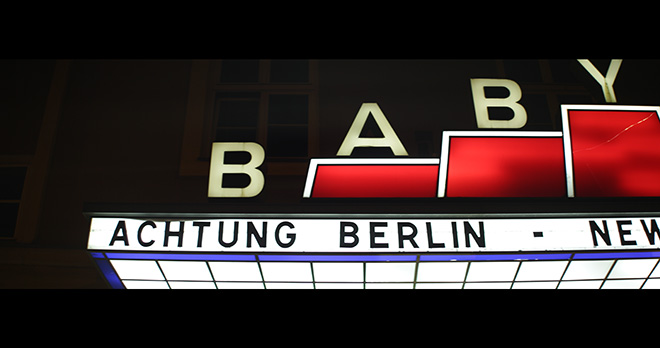Iscorama anamorphic on the 1D C and my test footage at Vimeo
I shot with the Canon 1D C and Canon C100 Cinema EOS cameras recently with SlashCam in Berlin. The 1D C is the most Jekyll and Hyde camera I’ve ever used and a difficult camera to review. The 1D C is a marriage of beautiful 4K images and an unwilling partner who hasn’t shifted an inch to accommodate it.
High end DSLR stills are ahead of even the best digital cinema cameras for image quality on a per-frame basis. The Nikon D800 does 7K raw images with 14.5 stops of dynamic range. If ever there was an opportunity to marry Canon’s expertise in high speed stills shooting to a moving image, the 1D C is it, but what a shame it makes no concessions at all to video ergonomics.
Image quality
The 4K image of the 1D C is way better than the best 1080p cameras like the C100 or C300, both in terms of the astounding level of resolution and the film-like feel to the image. Despite being only 8bit it really does banish any feeling of ‘video’ especially in Canon LOG mode.
Here’s a 1:1 crop from 4K:
And the original composition!
Viewing the 4K images on my 2.5K Dell 2711 the detail really does pop and I don’t even have a 4K screen yet. I enjoyed having my eye drawn to tiny details. That doesn’t happen in the same way with 1080p.
Although when viewed at 1:1 the 4K image is not quite at the mark of true 4K, it is still a significant leap from the C300. 4K also gives you the ability to crop in post if shooting 4K and delivering in 1080p but that will further reduce the full frame look of your lenses.
Here it is a full 4K frame (click the image to download it) with my Iscorama 36 anamorphic on the Contax Zeiss 50mm F1.4 –
In low light it is a new benchmark, completely displacing the Canon C100, C300 and Sony FS100. ISO 3200 is like silk, ISO 6400 is perfectly usable and even ISO 12,800 can be worked with especially if downsampled from 4K to 1080p and some light noise reduction applied in post.
Here’s a 1:1 crop of ISO 12,800 on both cameras. The C100 has been upscaled to 4K (as you can see, it is no match):
With noise reduction turned off you get the usual DSLR style noise (bright speckles of red and green) rather than a nice film-like grain (as seen on the Ikonoskop and Blackmagic Cinema Camera). With it turned on you risk a more plastic looking image and a drop in detail which is all the more noticeable in 4K mode. My advice is to turn noise reduction off and apply where needed in post if shooting at ISO 6400 and above.
Here’s the character of the noise for your pixel peeping pleasure…
Is the image better than a Red Scarlet, Blackmagic Production Camera 4K or FS700 with 4K recorder? That’s what the 1D C should be compared to. Certainly the 1D C has one advantage over the Scarlet (and likely Blackmagic S35 offering) – much cleaner in low light. However there’s no 12bit, 10bit, raw, global shutter, compressed raw, HD-SDI, peaking, no cinema camera features at all really. Rolling shutter is also a real issue on the 1D C – quite severe in 4K – so the global shutter equipped Blackmagic Production Camera certainly has an advantage when it comes to shooting fast paced action or handheld sequences.
Parts of the image suffered from a banding in the roll off to highlights, where the camera would render a steep drop to a blown highlight with just 2 or 3 bands of colour. There was a nice gentle roll off to blacks from the mids, but again a stepping of shades when going from dark grey to black over larger areas of the frame.
This 1D C only has 24p in 4K mode, the firmware update is due later. Under Berlin’s street lights the only usable shutter speed was 1/50 or 1/100, any other resulted in an unusable flickering image.
Canon log mode had an impressive effect on dynamic range, saving highlights and shadows where a normal picture profile would crush and burn. There are a few ungraded Log shots in the sample video for reference. I could happily shoot in low light with Canon Log without a significantly nosier image.
You can see my Log and low light test in the second half of the sample video (top of the page).
Overall, I am totally in love with the 4K image from the 1D C.
The 4K market
Inevitably 4K is the next cinema standard. Manufacturers are jostling for position. At this stage 4K is more important for the industry than the consumer (most of whom don’t yet need it). In the early days of a new standard it is important to establish a presence as Blackmagic are doing so with the Production Camera and Resolve 10. A state of the art 4K workflow from acquisition to post for $4000. Amazing.
Red have already established themselves technologically and Sony seem to be taking the lead with the F5 and F55 in the broader commercial videography market.
Canon’s 4K efforts are –
- The C500 – very expensive 1080p camera with a tweak to allow 4K
- The 1D C – very expensive stills camera with a tweak to allow 4K
Both the C500 and 1D C are a toe in the water, and Canon can’t be fully satisfied with their efforts. It is not an all guns blazing approach like Sony, Red or Blackmagic, it feels more like a side project at the R&D department, which is a huge shame given the imaging prowess of Canon’s stills sensor technology in the 1D X and 1D C.
The 1D C is a frustrating camera and I want to fall in love with her, but she happens to be a pain. You can’t have a camera review without a car analogy too, so it’s like having a Ferrari engine in a hover craft. It should really be in a car. Did that work!?
On an affordable DSLR you don’t mourn too much about the snared cinematic beauty trapped inside a stills camera. It is what it is. For Canon to offer such a tantalisingly beautiful 4K image in such an ill suited form factor at $12,000 is an avoidable situation because they could easily have put this sensor and 4K image in a C100 form factor for $6000 and owned the professional video world like they do stills with the 1D X. Sadly a huge added value with minimal overheads won the day.
Ergonomic problems
Using the 1D C on the same shoot as the C100 it becomes even more stark just how poor it is to use as a stills / video hybrid. Not a single concession has been made to the stills camera for video shooters apart from the additional 3 recording formats.
Unlike on most consumer DSLRs there’s no dedicated movie mode or record button, very much like the old 5D Mark II. The 1D C goes backwards from fundamental improvements Canon made with the 7D over the 5D Mark II way back 3 years ago – there’s no lever to switch live view mode between stills and video, instead the option is buried deep in the menus. This wouldn’t be such a problem if you could use the shutter release to grab a full frame raw still in the same mode you record 4K in but if you try this you get an error message. If you need to quickly grab a moment as a raw still, you have to exit live view altogether and use the optical viewfinder, or switch the live view mode to stills deep in the menus.
Canon log is also buried in the menus. When you eventually reach it, the Canon Log sub-menu contains 1 option – the option to turn it on! Only upon switching on Canon log does the reason for the sub-menu become clear – about 4 more parameters appear to fine tune stuff like saturation in log mode, then out you go through the cascading menus back to finally shoot. There’s no dedicated button to switch picture profile or quickly turn on or off Canon log!
Above: the form factor the 1D C’s image deserved but didn’t get
Setting ISO in live view mode obscures the frame with a list of ISO numbers on a darkened background. So to really see the effect of the exposure change you have to exit the ISO menu or half-guess at what the exposure looks like.
The start / stop button for video is assigned to a function button near the shutter release which is one of the least tactile and hardest to feel buttons on the camera, being so small and recessed. I recommend reassigning it to Set but there didn’t seem to be an option for this.
The focus assists for video – for there are none – come in the form of the usual stills magnification mode which every DSLR has, but unlike on a $400 T2i the button is placed awkwardly well away from any fingers and thumb in a bizarre location under the screen. Manually focussing really requires an external monitor, as shooting 4K requires precision sharpness but then you lose the DSLR stealth form factor and small size – so at over $12,000 why not just shoot with a proper cinema camera?
The crop factor in 4K mode is 1.3x and does not give either the full frame look to your lenses OR the Super 35mm look, as it is in-between. I’m used to building my lens collections around Super 35mm, Full Frame and Micro Four Thirds. APS-H is something else entirely and in 4k on the 1D C my Leica R 28mm feels something like a 36mm or 40mm and the character changes. This leads to inconsistency on a shoot with Super 35mm and full frame cameras, in terms of the look of lenses not just the field of view. On a full frame camera I have a beautifully gentle vignette on the Leica and yet it isn’t there on the 1D C in 4K.
1080p modes
The Super 35mm 1080p mode is sharp but I don’t consider it much of a selling point when you can get the same standard of Super 35mm 1080p from the C100 at $5500 without the ergonomic (and economic) struggle. In full frame 1080p mode the 1D C is identical to the $6000 1D X and the ‘new’ 1080/60p doesn’t seem very new when you realise it looks like upscaled 720/60p, which the much cheaper 1D X and 5D Mark III already have. Sneaky.
Downsampling 4K Canon Log to 1080p in post however results in a very cinematic image which definitely has the edge on the C100 and C300.
Battery capacity and screen
Most of my 1D C shoot involved me kneeling or crouching, or looking at a low battery indicator. Although the 600D has an articulated screen, and the GH3 has an articulated screen with weather sealing, the 1D C makes no concession to the video shooter here either despite being 12x more expensive than the GH3! As a result it is horrible to use bare bones, requiring constant kneeling or even lying down to be able to see the LCD when shooting on a tripod. Battery life is poor in video mode. Although almost a quarter of the camera body is taken up by a battery almost as wide as a 2.5″ SSD drive, it rates at just 2450mHa compared to the Nikon V1’s battery of 1900mHa and 5200mHa for the Canon C300 battery.
Above: my ultra small $400 Nikon V1 (seen here with Red Epic) has a similar capacity battery to the 1D C. What gives?
The Nikon V1 is a tiny mirrorless camera, the whole body is almost the size of the 1D C’s battery and yet manages to fit a camera in there somehow. Whilst we’re on the subject of space – the 1D C could easily have been designed to fit a 5200mHa Canon C100 battery and a 480GB Red mag sized SSD without increasing the size of the camera or dropping the DSLR form factor. A DSLR battery and CF card is all well and good for stills, to not upgrade these aspects for movie recording at $12,000 is not going to endear Canon to their customers very much.
Post
The 1D C is designed to fit into existing DSLR workflows (both post and production ones) and needs extensive rigging on a set to become more usable. That for me defies the point of having a DSLR in the first place – the stealth factor, the small size, the convenient marriage of stills and video in one device. Hollywood must surely have moved on from working around DSLR ergonomics now they can rig up the small Sony F55.
On common 600x compact flash cards the 4K mode randomly stops recording. On 1000x speed cards, your bank manager randomly calls during a shoot. On a 64GB 1000x CF card you can fit just 16 minutes of 4K footage, and archiving a year’s worth of footage becomes almost as expensive as archiving raw but with none of the benefits.
The 4K MJPEG is designed to fit existing workflows for Canon DSLR or Cinema EOS footage, but even on powerful Mac Pro hardware and CUDA I couldn’t get smooth playback in Premiere CS6. Changing playback resolution to 1/2 or 1/4 didn’t help, which leads me to believe the bottleneck is the drive, but the files were being streamed of a RAID 0 array of 3! The poor performance of MJPEG could be due to Premiere selecting the wrong mode for playback as it is not used to coping with MJPEG at such high resolutions (maybe the wrong playback buffer size). One mooted solution is to transcode to ProRes 4K but then your storage requirements bloom to even more unmanageable proportions. It has been suggested that simply changing the file extension to MPG (MPEG) to force Premiere to handle MJPEG in a better way, can give smoother results – I will try this on my next shoot.
It is clear at this point that the 1D C is not going to be a C100 or C300 replacement for those wanting 4K as it doesn’t even touch the Blackmagic Production Camera for ergonomics let alone Red or Sony. Consumer mirrorless cameras like the Panasonic GH3 and DSLRs have better video ergonomics for well under $1000.
Conclusion
I’m left in mourning for Canon’s early 4K efforts. For a start the price makes them an incredibly risky ownership prospect. In the case of the C500 would you blow $25,000 on a big petrol hungry car knowing it would cost you a lot to run and depreciate by $10,000 in the coming 12 months? The 1D C is also at risk of huge depreciation. I know many who can afford the asking price, but not many willing to risk the depreciation for 4K they don’t really need yet.
If the 1D X sensor can do 4K video, just put it in the 1D X and sell loads! I don’t understand Canon’s business strategy for charging $12,000 for a small quantities of a barely modified camera based on one that is relatively mass produced. The establishing of a new standard it is an opportunity to create space for one’s self and really push aggressively for market share, because there’s a whole television and film industry to feed, a billion dollar industry just beginning to build around and invest in 4K content. It is important to get there first and in the right way. The 1D C is not the right way.
The same flawed approach has been taken with the C500 which is almost identical to the C300 and requires an external recorder. Canon do not have the software or post production products to do an end-to-end workflow like Blackmagic for $25,000 let alone $4000. The fan on the C500 is too loud and the cabled external recorder isn’t an integrated solution like on the much cheaper Sony F5.
The Canon 1D X is designed to be held to the eye and the sensor is a very fast one, enabling sports shooters to capture full resolution stills at up to 14fps and “hey look we can also do 4K, charge double!”, but it has worse ergonomics for video than the $700 Nikon D5200 consumer DSLR, less video optimisations than 2009’s GH1 and all for that bargain price of $12,000 in the form of the 1D C. I’m a big believer in the end result (the image) being what counts. Though I was always happy to work around the shortcomings of DSLRs at $1000, to be working around them at $12,000 seems obscene.
Pros wishing to mix stills and video on one shoot will be frustrated that the 1D C does convergence so poorly. You might be better off with a separate 1D X and a Blackmagic Production Camera for the same money. It isn’t that the DSLR form factor hinders video on the 1D C, it is that absolutely no attention has been paid to making this particular DSLR form factor work better! Zero! It is purely a stills camera, designed for photographers not filmmakers, that happens to record video to compact flash cards. 4K or not, that’s a lazy implementation of video considering the asking price.
The 1D C follows a familiar pattern of late for Canon. A great story, stifled by a cynical product strategy, coasting into our consciousness on a wave of good will from Hollywood. By current form I’ll be getting my 4K acquisition solutions from Blackmagic Design or Sony.
Pros
- Lovely end results in 4K, silky smooth and amazing detail
- World leading low light performance at high ISOs
- A flagship stills camera and same robust build quality as the 1D X
- Sharp in 1080p with Super 35mm crop (but the C100 has that for a lot less money)
- Ready to shoot out of the box (though painful to use bare bones)
- Internal 4K recording to common media and no need for external solution aka C500 (though media is expensive)
Cons
- Absurdly high price and huge potential for depreciation
- 4K only real selling point over half priced 1D X, but benefit of 4K questionable for audience and clients in 2013. By the time it becomes an industry standard the 1D C may well be obsolete!
- Zero handling concessions to video, not even a video record button on a $12,000 movie camera!!
- Live view activation required every time you turn on the camera
- No dedicated movie mode
- 4K mode has an odd crop factor, nowhere near the full frame look to lenses
- Very poor rolling shutter performance especially in 4K mode
- Mushy 1080/60p image quality looks like upscaled 720p
- Poor battery run time and low capacity considering physical size
- Cannot quickly shoot stills whilst in 4K recording mode
- Live view stills / movie mode hidden deep in the menu, no dedicated lever like on the 5D Mark III
- Video quality in full frame 1080p mode barely better than a $3000 5D Mark III, vertically smeared
- Expensive media (1000x 150MB/s 128GB CF minimum standard) and many cards required
- 4K requires card speeds above 100MB/s – only a little more optimisation would have enabled use of cheaper 600x 95MB/s cards
- No form factor excuse for not using small customised SSD mags like Odyssey 7Q / Red
- 8bit disappointing to see at $12,000, banding an issue under ISO 400 especially in Canon LOG mode
- Canon log buried deep in the menus
- No direct access to picture profiles like on consumer DSLR
- ISO menu obscures entire exposure / composition
- Poor feel to m.Fn button near shutter release (default for activating movie recording)
- Buttons, even the on / off switch impossible to see in the dark
- Illumination of top and rear info panels turns off whilst recording
- Menu system designed for stills shooters (lots of pages of AF!)
- Focus assist not designed for video shooting, no peaking
- Awkward positioning of magnified focus assist, more apt for playback mode than shooting
- Magnified focus assist too slow to move around the frame
- Awkward to use on a tripod for bare bones DSLR stealth shooting – no articulated monitor, stealth factor disappears when you add monitor
- Requires firmware update for 25p (and only came about after months of requests)
- Not nearly enough changes to the 1D X to justify doubling of the price
- No high frame rates (HFR) in 4K, not even 30fps
- Poor 4K editing performance in Adobe Premiere CS6 due to inefficient MJPEG codec and possibly compatibility issues



